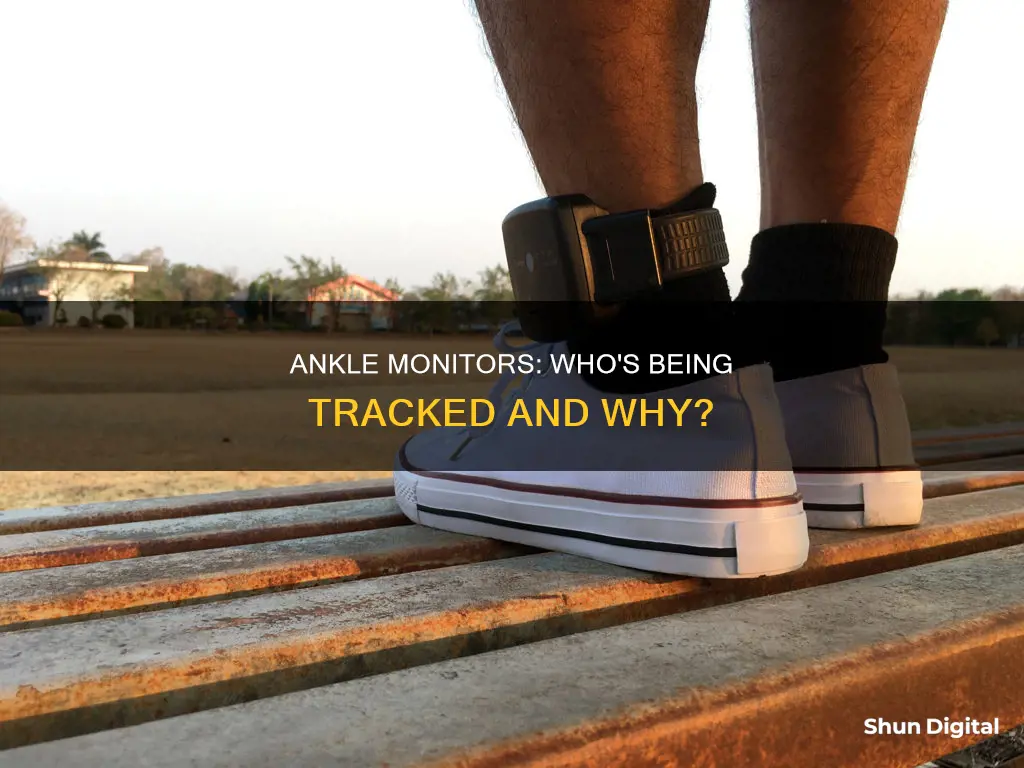
Ankle monitors are electronic surveillance devices that track the location of their wearers, typically using GPS technology. These devices are often court-ordered for individuals awaiting trial, serving probation or parole, or facing immigration proceedings. They are designed to restrict an individual's movements and can be used as an alternative to incarceration. The use of ankle monitors has been controversial, with critics arguing that they fail to meet their stated goals of ensuring court appearances, protecting public safety, and promoting rehabilitation. Additionally, the monitors have been associated with social stigma, isolation, and increased stress for the wearers, impacting their mental health and well-being.
What You'll Learn

Who wears ankle monitors?
Ankle monitors are typically worn by people who are awaiting trial, serving probation or parole, or facing immigration proceedings. They are also used for those released from prison under the condition of mandatory supervised release, or for people who are temporarily released from jail to a treatment centre. Ankle monitors are also used for alcohol monitoring, with the SCRAM CAM® bracelet providing 24/7 transdermal alcohol testing for drunk drivers, and those with high-risk alcohol and domestic violence caseloads.
Ankle monitors are often used as an alternative to incarceration, and their use has been rising. From 2005 to 2015, the number of active electronic monitors in use rose by 140%. During the COVID-19 pandemic, some jurisdictions also turned to ankle monitors as a way to slow the spread of the disease and reduce prison populations.
The monitors are typically GPS tracking systems, and they can be used to record the location of the wearer, as well as limit how long they can stay outside and where they can go. They are often referred to as ankle bracelets, ankle shackles, or tethers.
The cost of wearing an ankle monitor can range from $3 to $35 per day, with initial setup charges of $100 to $200. These costs can be a significant financial burden, especially for those already dealing with the return of a family member from incarceration.
There are also social and psychological impacts associated with wearing an ankle monitor. The stigma, social isolation, and stress that result from being monitored can exacerbate depression and anxiety for wearers. Additionally, the restrictions on movement can make it difficult for individuals to work, attend school, or access necessary services.
Chevy's Blind Spot Monitoring: A Comprehensive Safety Feature
You may want to see also

Why do people wear ankle monitors?
Ankle monitors, also known as electronic monitoring or house arrest bracelets, are devices worn around the lower leg to track an individual's movements. They are typically used as an alternative to incarceration, allowing people to remain free while awaiting trial or serving probation and parole. They can also be used as a condition of bail or parole for certain crimes, such as serious offences like murder, sexual assault, or major drug offences.
One of the primary reasons for ankle monitors is to ensure that individuals do not violate the terms of their sentence or release. This includes monitoring for sobriety, especially in the case of DUI or DWI convictions, where an ankle monitor can detect alcohol in a person's sweat and alert authorities if they consume alcohol. Ankle monitors can also be used to enforce protective orders in domestic violence cases, ensuring that offenders maintain a required distance from their victims.
In some cases, ankle monitors may be used as a form of risk reduction for individuals who are deemed a flight risk or a danger to the community. By setting specific boundaries and restrictions, authorities can ensure that these individuals do not leave a designated area. This also helps with easy tracking, as GPS monitoring allows authorities to locate someone quickly if they do decide to flee.
During the COVID-19 pandemic, ankle monitors were also used as an alternative to incarceration to slow the spread of the disease in prisons and jails. However, the use of electronic monitoring has been criticised by organisations like the ACLU, which argues that it expands mass incarceration and leads to further stigmatisation and social isolation for those being monitored.
Understanding Monitor Types: LED vs LCD Displays
You may want to see also

How do ankle monitors work?
Ankle monitors, also known as ankle bracelets, ankle shackles, or tethers, are electronic monitoring devices that use GPS tracking systems to record the location of their wearers. They are typically court-ordered for individuals awaiting trial, serving probation or parole, or facing immigration proceedings. The device is attached to the ankle and tracks the wearer's movements, usually with the goal of ensuring they adhere to specific conditions or restrictions set by a court or correctional facility.
The ankle monitor uses GPS technology to transmit real-time location data to a monitoring centre or law enforcement agency. This allows authorities to track the wearer's movements and ensure they are complying with any court-ordered restrictions, such as house arrest or exclusion zones. The monitors can also be used to set boundaries for how long a person can stay outside and where they can go. In addition to GPS tracking, ankle monitors may also include other features such as alcohol monitoring, which can detect if the wearer has consumed alcohol.
The ankle monitor is typically secured to the individual's ankle with a strap that has a built-in fibre optic cable. This cable is connected to the main unit of the monitor and is designed to detect any tampering. If the strap is cut or stretched, it triggers an alert, notifying the monitoring centre or law enforcement that the device has been tampered with. The monitor also includes a battery that needs to be recharged regularly, and the wearer is usually given strict rules about charging to prevent non-compliance.
While ankle monitors are intended to provide an alternative to incarceration and promote rehabilitation, there are concerns about their effectiveness and potential negative impacts. Studies have shown that monitors may fail to meet their stated goals of ensuring court appearances, protecting public safety, and facilitating rehabilitation. Instead, they can contribute to mass incarceration, leading to individuals being sent back to jail for minor technical violations, charging malfunctions, or false alarms. Additionally, ankle monitors can exacerbate systemic inequities, with certain communities, such as Black individuals in Detroit, being disproportionately affected by electronic monitoring.
Opening the Back of an Asus VX238 Monitor
You may want to see also

How much do ankle monitors cost?
The cost of an ankle monitor varies depending on location and individual circumstances. Private companies that provide ankle monitors in the US charge users hundreds of dollars a month, with daily fees ranging from $3 to $40. Setup fees can range from $100 to $200, with an average of $175.
In some places, the state pays for ankle monitors for those who cannot afford them. However, in many cases, individuals are expected to cover the cost themselves, which can lead to debt and unemployment. The high cost of ankle monitors can create a cycle of poverty, as people struggle to pay the fees while also facing difficulties in finding employment due to the stigma associated with the devices.
In addition to the cost of the device itself, there may also be other associated costs, such as transportation to and from check-ins and court hearings. Ankle monitors can also lead to increased utility costs, as they need to be charged regularly.
The cost of ankle monitors can be a significant financial burden, especially for those who are already in a vulnerable financial situation. The expense of these devices can have a significant impact on a person's life, affecting their ability to find employment, attend social events, and participate fully in society.
Easy Monitor Driver Installation Guide for Asus VG248QE
You may want to see also

What are the problems with ankle monitors?
Ankle monitors, also known as ankle bracelets or shackles, are GPS-equipped devices used to track the location of their wearers. They are often used as an alternative to incarceration for people awaiting trial, on probation or parole, or facing immigration proceedings. While they are intended to provide a more humane option to imprisonment, there are several problems associated with their use.
One of the primary issues with ankle monitors is their impact on the mental health and well-being of those who wear them. The constant surveillance and restriction of movement can lead to social isolation, stress, anxiety, and depression. In a report by the ACLU, individuals shared their experiences of the negative mental health effects of wearing ankle monitors, including panic attacks, stress, and feelings of being judged by others. Additionally, the physical presence of the monitor can be a source of discomfort and inconvenience, with some people reporting that the device was too tight or too loose, causing muscle contractions and feelings of entrapment.
Another problem with ankle monitors is the financial burden they place on the wearer. In many jurisdictions, individuals are required to pay daily fees for the surveillance devices, which can range from $3 to $35 per day, in addition to initial setup charges. These expenses can quickly add up, creating a significant financial strain, especially for those who are already struggling financially due to incarceration or other circumstances. Furthermore, the requirement to maintain constant contact with supervising agents can result in additional costs for phone and internet services, further compounding the financial burden.
Ankle monitors have also been criticised for their negative impact on employment and social relationships. The restrictions on movement and the need to obtain approval for leaving the house can make it difficult to maintain stable employment or attend social events. The visibility of the monitor can also lead to stigma and judgment from others, affecting interpersonal interactions and relationships. In some cases, individuals may lose their jobs due to the direct or indirect effects of wearing an ankle monitor, such as difficulty performing certain tasks or the perception of being a "criminal".
Lastly, ankle monitors have been criticised for violating privacy rights and restricting fundamental freedoms. The devices capture, analyse, and store location and movement data, which is often shared with law enforcement agencies and the courts. This lack of privacy can extend to the friends and family of the wearer, as it may involve random and invasive home searches. The vague and overly broad rules associated with ankle monitors can set people up for failure and reincarceration, as even minor technical issues or rule violations can result in a return to prison.
Easy Holter Monitor Sticker Removal: Tips and Tricks
You may want to see also
Frequently asked questions
Ankle monitors are typically worn by people who are on house arrest, probation, or parole. They are also worn by people who are awaiting trial, and in some cases, by those who are unable to pay bail.
Ankle monitors are used as an alternative to incarceration. They are often used to track the location of the wearer and ensure they do not leave a designated area. They can also be used to detect alcohol consumption, which is particularly useful for enforcing restrictions on individuals with alcohol-related offences.
Ankle monitors use GPS or radio frequency technology to transmit location data to a monitoring centre. They are locked in place to allow for ongoing, accurate monitoring and some have inbuilt sensors that notify authorities if they are tampered with.







